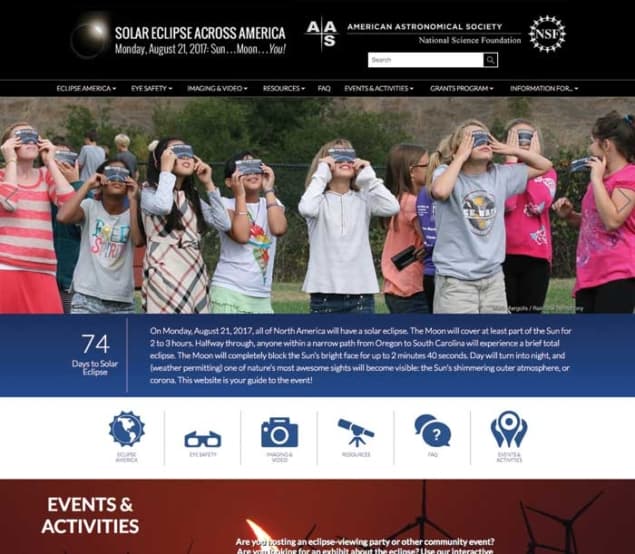
So what is the site about?
Eclipse America is a one-stop shop for everything concerning next month’s total solar eclipse in the US, as its 70-mile-wide shadow tracks it way from Oregon in the west to South Carolina in the east on Monday 21 August 2017. The event will be witnessed by approximately 12 million people during the late morning through to the mid-afternoon as it passes across this vast country. The website includes a detailed map that illustrates the path of totality, and the best possible locations from which to view the total eclipse. It also shows the degree of partial eclipse visible to the north and south of the Sun’s path (there will be a partial eclipse visible from north-west Europe) and includes advice and information to help viewers enjoy the eclipse safely. The site gives a concise and user-friendly overview of the phenomenon, explaining how this rare and spectacular event will one day no longer be witnessed on Earth, as the Moon moves further away and its apparent size shrinks over time.
Who is behind it?
The Eclipse America website is hosted and run by the American Astronomical Society (AAS) whose large membership is made up of physicists, mathematicians, geologists and engineers with an interest in contemporary astronomy. The society aims to enhance people’s understanding of the universe and advance physical sciences for the benefit of all.
What are some of the topics covered?
Eye safety forms a large section of the website, with a short video and several pages advising viewers how to protect their eyes while viewing the eclipse. The site advocates using eclipse shades or a solar filter on specialist equipment, while also offering advice on how to verify that equipment is safe and complies with ISO12312-2 standards. It also suggests other methods via which the event can be enjoyed and viewed safely such as pinhole projection and instructions on how to make a sun funnel. Guides for educators and community leaders are included in the downloads section along with links to articles about eye care. The Solar Eclipse Experience page provides a detailed account and associated images of a solar eclipse, from “first contact” through every stage until the Sun re-emerges. There is also a helpful glossary that explains eclipse terminology, as well as a description of what to expect when weather conditions are cloudy. A handy resources page forms a collection of further reading, advice, maps and images as well as recommendations of the most up-to-date apps and software.
Who is it aimed at?
As a total solar eclipse is a relatively rare event, the spectacle will undoubtedly generate a lot of public interest. Eclipse America has wide appeal and is aimed at anyone with an interest in witnessing this “cosmic coincidence”, from dedicated eclipse chasers keen to record the event, to educators, community leaders and children. For budding or professional photographers, a section advises how to capture the perfect solar eclipse image or video and also provides valuable advice on copyright and accreditation. The educational materials and videos page are conveniently grouped in age-related collections, which make the resources easily accessible by teachers, lecturers and outreach providers.
How can I take part?
The website encourages people to get involved in various ways, from downloading the instructions to make a sun funnel or becoming a citizen-scientist by signing up to one of the Citizen Science Projects. If you’re in the US, you can search for an eclipse-related event taking place near you by using an interactive map or contacting the AAS to have your lecture, presentation or conference included on the website.
Can you give me a sample quote?
So what is so special about a solar eclipse? More of an experience than an event, the Eclipse America website describes it as “hauntingly beautiful and, without doubt, one of the most awesome sights in all of nature”. And the following description sufficiently raises expectations: “At the beginning and end of totality, the thin middle layer of the Sun’s atmosphere, the chromosphere, blazes in an arc of ruby red. The sky darkens to a deep twilight blue, with yellow, orange, and pink sunrise/sunset colours on the horizon in all directions. Bright stars and planets shine forth, and the air temperature drops noticeably. Birds and farm animals, thinking dusk has settled, return to their nests and barns, and bats come out to feed.” If that doesn’t sell it, then nothing will.
- Enjoy the rest of the July 2017 issue of Physics World in our digital magazine or via the Physics World app for any iOS or Android smartphone or tablet. Membership of the Institute of Physics required



